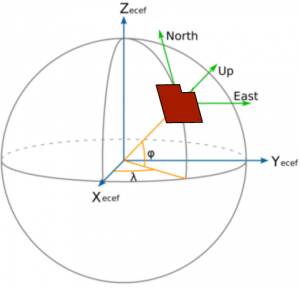WGS84
The Earth is Not Round! Utah, NAD83 and WebMercator Projections
By the Utah Automated Geographic Reference Center
It says that "The UTM NAD83 projection uses the GRS80 ellipsoid and a center-of-the-earth anchor point as its datum,"
The California Coordinate System
“ The State Plane Coordinate System was established to provide a means for transferring the geodetic positions of monumented points to plane coordinates that would permit the use of these monuments in plane surveying over relatively large areas without introducing significant error.
A plane-rectangular coordinate system is by definition a flat surface. Geodetic positions on the curved surface of the earth must be “projected” to their corresponding plane coordinate positions. Projecting the curved surface onto a plane requires some form of deformation. Imagine the stretching and tearing necessary to flatten a piece of orange peel. In California the Lambert Conformal map projection is used to transform the geodetic positions of latitude and longitude into the y (Northing) and x (Easting) coordinates of the CCS83. ”
We read that the geographic (spherical) coordinates are projected to the plane coordinates. Not the other way around.
West Virginia GIS Technical Center
“ Geographic Coordinate System (GCS): An unprojected coordinate system that uses latitude and longitude to define the locations of points on a sphere or spheroid. The use of longitude and latitude is encouraged for general reference and distribution of national framework data because it provides a seamless coordinate system for most of the United States. Geographic coordinates can be readily projected onto a planar coordinate system to display data properly or measure distances accurately. The Geographic Coordinate System is the recommended coordinate system for unprojected GIS data sets that cover the entire geographic extent of West Virginia. ”
We read that the geographic (round earth) coordinates can be projected onto a planar (flat earth) coordinate system to accurately display distances.
The reader should ponder how spherical coordinates projected onto a planar coordinate system could display data and distances accurately if the earth is a globe. Why should these systems require that? Are naps with spherical coordinates are not possible?
If the earth is a globe, the opposite should be true. Projecting spherical coordinates onto a plane should make data and distances more inaccurate. Not accurate.
Anchor Point Datum
"The UTM NAD83 projection uses the GRS80 ellipsoid and a center-of-the-earth anchor point as its datum,"
First it talks about the spherical model:
“ Geographic coordinates use latitude and longitude values to define positions on the 3D surface of the earth, which is of course, best modeled as an ellipsoid, not a sphere. The ellipsoid and its accompanying anchor point that ties it in to the real world, are known collectively as the WGS84 datum. ”
Note "real world."
Then it talks about the flat model:
“ UTM NAD83 is a projected coordinate system that represents physical locations abstracted to a flat, cartesian coordinate system. The UTM NAD83 projection uses the GRS80 ellipsoid and a center-of-the-earth anchor point as its datum ”
The passage is speaking of an anchor point to connect the two types of systems together.
The accompanying image is the flat map with anchor point:

